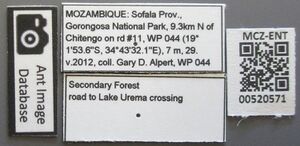Monomorium arnoldi
| Monomorium arnoldi | |
|---|---|

| |
| Scientific classification | |
| Kingdom: | Animalia |
| Phylum: | Arthropoda |
| Class: | Insecta |
| Order: | Hymenoptera |
| Family: | Formicidae |
| Subfamily: | Myrmicinae |
| Tribe: | Solenopsidini |
| Genus: | Monomorium |
| Species: | M. arnoldi |
| Binomial name | |
| Monomorium arnoldi Forel, 1913 | |
Arnold (1916) says that he has only found this species running on the branches of an unidentified tree which had green bark, the bark being covered by 'a thin yellowish and parchment-like outer skin, which is also waxy.' He states that the colour of the ants matches the skin of the tree very closely so that they are difficult to detect even when moving. (Bolton 1987)
Identification
Bolton (1987) - A member of the M. altinode complex in the M. monomorium species group. Notes on the separation of arnoldi from its closest relatives are given under Monomorium altinode.
Keys including this Species
Distribution
Latitudinal Distribution Pattern
Latitudinal Range: -15.60113889° to -20.58333°.
| North Temperate |
North Subtropical |
Tropical | South Subtropical |
South Temperate |
- Source: AntMaps
Distribution based on Regional Taxon Lists
Afrotropical Region: Zimbabwe (type locality).
Distribution based on AntMaps
Distribution based on AntWeb specimens
Check data from AntWeb
Countries Occupied
| Number of countries occupied by this species based on AntWiki Regional Taxon Lists. In general, fewer countries occupied indicates a narrower range, while more countries indicates a more widespread species. |

|
Estimated Abundance
| Relative abundance based on number of AntMaps records per species (this species within the purple bar). Fewer records (to the left) indicates a less abundant/encountered species while more records (to the right) indicates more abundant/encountered species. |

|
Habitat
Specimens have been collected from savanna woodland and forest habitats.
Biology
Castes
Worker
   
| |
| . | Owned by Museum of Comparative Zoology. |
   
| |
| . | Owned by Museum of Comparative Zoology. |
Nomenclature
The following information is derived from Barry Bolton's Online Catalogue of the Ants of the World.
- arnoldi. Monomorium arnoldi Forel, 1913a: 137 (w.) ZIMBABWE.
- Type-material: syntype workers (number not stated).
- Type-locality: Zimbabwe (“Southern Rhodesia”): Matopo Hills (G. Arnold).
- Type-depositories: BMNH, MCZC, MHNG.
- Status as species: Arnold, 1916: 232; Emery, 1922e: 171; Wheeler, W.M. 1922a: 863; Ettershank, 1966: 87; Bolton, 1987: 378 (redescription); Bolton, 1995b: 259.
- Distribution: Zimbabwe.
Unless otherwise noted the text for the remainder of this section is reported from the publication that includes the original description.
Description
Worker
Bolton (1987) - TL 2.0-2.1, HL 0.52-0.54, HW 0.40-0.41, CI 74-77, SL 0.38-0.40, SI 95-98, PW 0.23-0.25, AL 0.48-0.52 (7 measured).
Clypeal carinae well developed, widely divergent anteriorly and running to the margin. Space between the carinae shallowly transversely concave in front of the level of the frontal lobes. Clypeal carinae terminating in a pair of projecting low denticles, the anterior margin of the prominent median portion of the clypeus shallowly concave between them. Maximum diameter of eye 0.20-0.22 x HW and with 5-6 ommatidia in the longest row. With the head in full-face view the eyes distinctly in front of the midlength of the sides and the scapes, when laid straight back from their insertions, failing to reach the occipital margin. Sides of head straight to shallowly convex in full-face view, rounding posteriorly into the broad occipital margin, which is transverse to feebly concave. Promesonotum convex in profile, sloping posteriorly to the impressed metanotal groove; the latter traversed by short but conspicuous cross-ribs. Propodeal dorsum evenly convex, its spiracle small. Petiole node high and narrow, anteroposteriorly compressed and narrowly rounded above. Subpetiolar process a narrow and inconspicuous strip. Postpetiole with a high vertical anterior face, more broadly rounded above than the petiole node. All dorsal surfaces of head and body with standing hairs, the promesonotum with 5-6 pairs (possibly more as all available material is somewhat abraded). Head and body entirely smooth except for minute hair-pits, metanotal cross-ribs and some very faint sculptural vestiges on the mesopleuron. Colour yellow to light brownish yellow, glossy.
Type Material
Bolton (1987) - Syntype workers, Zimbabwe: Matopo Hills (G. Arnold) (The Natural History Museum; Musee d'Histoire Naturelle Genève; Museum of Comparative Zoology) [examined].
References
- Arnold, G. 1952a. New species of African Hymenoptera. No. 10. Occas. Pap. Natl. Mus. South. Rhod. 2: 460-493 (page 465, Replacement name: jonesi)
- Bolton, B. 1987. A review of the Solenopsis genus-group and revision of Afrotropical Monomorium Mayr (Hymenoptera: Formicidae). Bulletin of the British Museum (Natural History). Entomology. 54: 263-452.. (page 378, see also)
- Forel, A. 1913a. Fourmis de Rhodesia, etc. récoltées par M. G. Arnold, le Dr. H. Brauns et K. Fikendey. Ann. Soc. Entomol. Belg. 57: 108-147 (page 137, worker described)
- Heterick, B.E. 2022. A guide to the ants of Western Australia. Part II: Distribution and biology. Records of the Western Australian Museum, supplement 86: 247-510 (doi:10.18195/issn.0313-122x.86.2022.247-510).
- Jansen, G., Savolainen, R., Vepsäläinen, K. 2010. Phylogeny, divergence-time estimation, biogeography and social parasite–host relationships of the Holarctic ant genus Myrmica (Hymenoptera: Formicidae). Molecular Phylogenetics and Evolution 561, 294–304 (doi:10.1016/j.ympev.2010.01.029).
- Santschi, F. 1921c. Quelques nouveaux Formicides africains. Annales de la Société Entomologique de Belgique 61: 113-122 (doi:10.5281/ZENODO.14442) (page 120, fig. 2 worker described)
References based on Global Ant Biodiversity Informatics
- Forel A. 1913. Fourmis de Rhodesia, etc. récoltées par M. G. Arnold, le Dr. H. Brauns et K. Fikendey. Annales de la Société Entomologique de Belgique 57: 108-147.
- IZIKO South Africa Museum Collection

